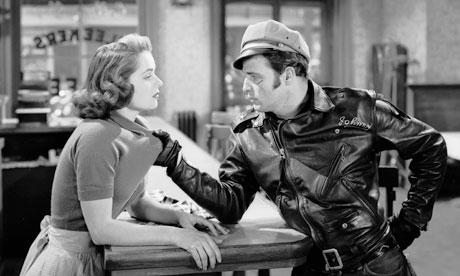Hollywood actor who shot to fame as Marlon Brando's girlfriend in The Wild One

Mary Murphy and Marlon Brando in The Wild One. Their characters’ romance was doomed.
Co-starring with Marlon Brando in his prime is a bonus for any actor's filmography. The fame of Mary Murphy, who has died aged 80, was boosted considerably when she played his love interest in The Wild One (1953). Tame by today's standards, it was the film in which the brooding, rebellious, black-leather-clad Brando, as the leader of a motorcycle gang, emerged fully as a sex symbol. The pretty, clean-cut Murphy, never considered a sex symbol herself, served as an excellent foil to Brando who, when asked what he is rebelling against, replies: "What've you got?" As the sheriff's daughter, she immediately attracts the attention of Brando when he comes in for a beer at the diner where she works. Gradually, the attraction becomes mutual as he rides his large, phallic motorcycle with her clutching his waist, her hair blowing wildly in the wind. Although their romance is doomed, her love for him is redemptive. Spared the dated 1950s slang ("crazy daddy-o"), Murphy perfectly portrays a "square" small-town girl whose suppressed restlessness is stirred by the forbidden encounter. Murphy was born in Washington DC, spent most of her early childhood in Cleveland, Ohio, and her teens in California. While working as a package wrapper at Saks Fifth Avenue on Wilshire Boulevard in Beverly Hills, without any thoughts of an acting career, the 18-year-old was spotted in a coffee shop by a talent scout for Paramount Pictures. While the studio put her through acting, singing and dancing classes, Murphy appeared in 11 Paramount films in bits or small parts, starting in The Lemon Drop Kid (1951), starring Bob Hope. "I'll never forget that first picture," Murphy said, "nor the one line of dialogue I had in it. The line was, 'I'm sorry, I haven't got any change.'" She had a few more lines as Laurence Olivier's daughter in William Wyler's Carrie (1952). It was only after she left Paramount that Murphy began to get leading roles, her first being in MGM's Main Street to Broadway (1953). However, the flimsy central plot, featuring Murphy as an ambitious stage actor in love with an aspiring playwright (Tom Morton), was swamped by the film's gimmick of having almost every star then working on Broadway make "in person" appearances. Nevertheless, she managed to land the role in The Wild One in the same year. She found the film a learning experience because "Marlon didn't always stay precisely to the script – and that was something I had always done. He'd sort of change the sentence structure of a line, maybe add or edit out a word here or there. That forced me to really listen, because I never knew for sure what he was going to say next." Now in demand, Murphy went on to star in four films in 1954, none of them particularly challenging. Beachhead, a tale of jungle warfare in which she was a plucky French planter's daughter, making her way with US marine Tony Curtis through Japanese-held territory; The Mad Magician, in which she was the villainous Vincent Price's stage assistant; Make Haste to Live, as the daughter of a woman in peril; and Sitting Bull, as the wife of an American major (Dale Robertson) seeking peace with the Sioux. It was during the filming of Make Haste to Live that she and her brawny co-star Robertson became romantically involved. They married in 1956, but the marriage was annulled six months later because Murphy claimed her husband did not want children. Meanwhile, Murphy was kept busy in television, predominantly as a guest star in western series such as Wagon Train and Laramie, and in features, the most prestigious being Wyler's The Desperate Hours (1955), with Humphrey Bogart in gangster mode, threatening a middle-class family. Murphy, still young enough looking at 24 to play the spirited teenage daughter, is the object of desire of Bogart's depraved younger brother (played by Dewey Martin). Perhaps with The Wild One in mind, she was again cast as a teenager in Live Fast, Die Young (1958), billed as "the sin-steeped story of today's beat generation". Murphy's penultimate film role before retiring was as the bitchy sister-in-law of a rodeo rider (Steve McQueen) in Sam Peckinpah's Junior Bonner (1972). In 1962 Murphy married Alan Specht, the president of a chain of lighting stores. They divorced in 1967. Their daughter, Stephanie, survives her. • Mary Murphy, actor, born 26 January 1931; died 4 May 2011
No comments:
Post a Comment